Finally, it’s the software distortion we’ve been waiting for. No silly graphics, no fake hardware effects, no blunt-instrument processing. Thermal is distortion as actual sound design tool.
Output has been evolving toward this for a while. Their layered instruments already combined layers of modulation and multiple engines for sound manipulation. And Portal, their granular effect, already offered a sophisticated multi-pronged approach to a largely experimental sound design process.
Thermal takes that approach and adds it to distortion and and a suite of sound coloring, time shifting (including phaser/flanger), width and tone shaping controls.
It’s not that I mind the effects out there that just mangle sounds, stompbox style – that’s fun. (Random KVR VSTs and Reaktor ensembles, here I come!) But Thermal is the first set of distortion tools that really let you hone in on what you’re doing. So if you just want to completely demolish a sound, stacking up sounds, you can do that. But if you want to precisely manipulate harmonic content by band, combine nuanced stages and layers, and add modulation, this tool utterly nails it. And because of its graphical controls, it’s easy to see what you’re doing, and how the sound is responding, even building a preset from scratch.
Also, I’ll be honest – I wound up steering away from granular effect Portal in some projects because it was pretty CPU-heavy. (To be fair, that’s always an issue with granular synthesis once you up grain polyphony.) But Thermal is mercifully CPU light, enough so that it may prove really addictive.
As with other Output tools, you’re greeted with some X/Y controls and a bunch of effects – some pretty drastic. But I think it’s actually easier to explain what Thermal is and how to use it if you start with the default and build it from scratch. That’s especially true because there are really a ton of modules and modulation – this is like the Massive or Serum of effects. So if you just randomly pull up presets, you’re really missing out on understanding individual modules and tailoring to what you want to do.
Click for larger images.
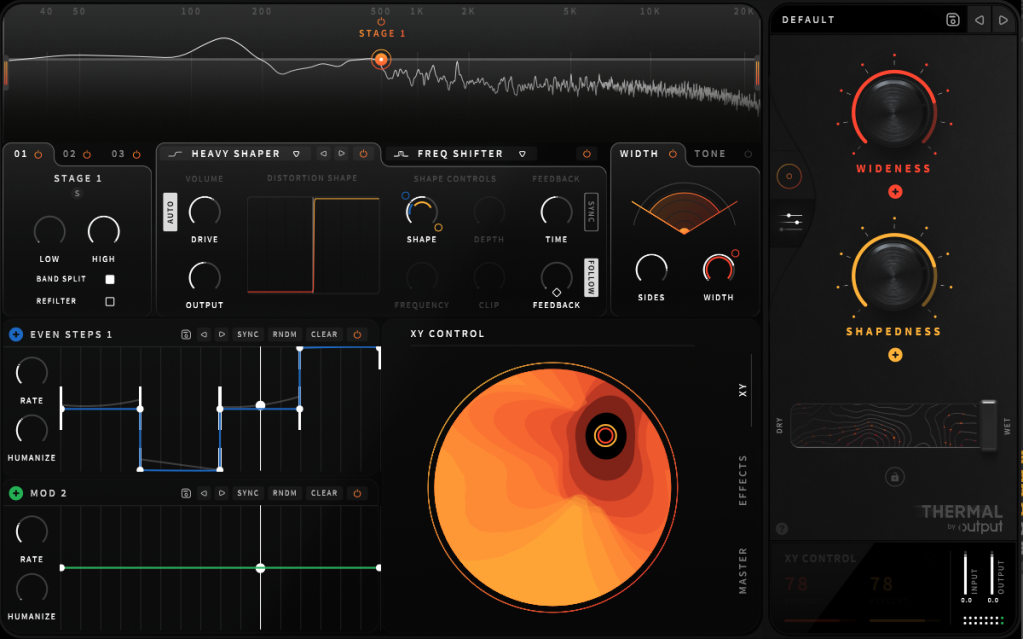
First, the overall window, which is divided into submodules. Click on the faders, as with past Output offerings, to bring up the “advanced” view where you can actually control what you’re doing.
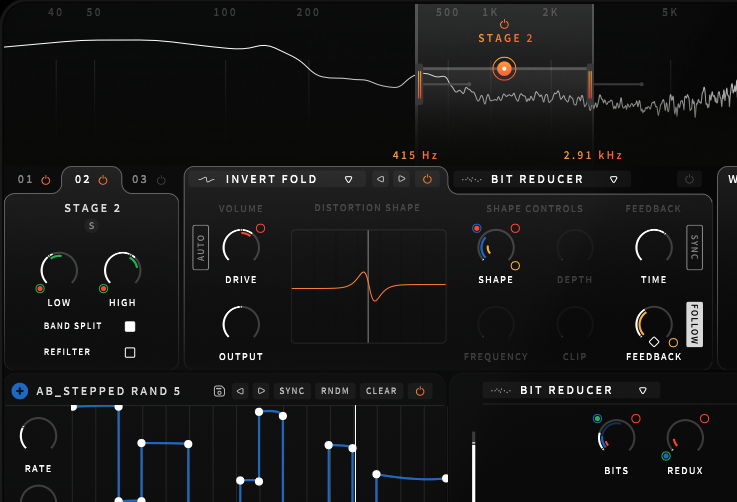
It comes in stages. There are three stages in each sound, each of which contains both a stage filter (both high/low crossover frequencies) and a selectable distortion/saturation algorithm, and a second filter/effect. That’s right – that’s 3x distortion stages and 3x filter/effect stages even before the master effects (two of those) and width and tone controls.
For each stage, you hone in on the frequency range you want. You get simple low and high knobs, but also a visual display of the waveform with draggable cutoff frequencies, and the ability to solo the band so you can listen to it.
This is powerful enough that one of the first things you should do even when applying a preset is to adjust the stage frequencies to your source material. You can get some radically different results, even just by experimentation.
There’s also a Refilter control for each stage which filters the post effect signal again – in case you have harmonics outside of that frequency range you want to clean up after distortion and effects.
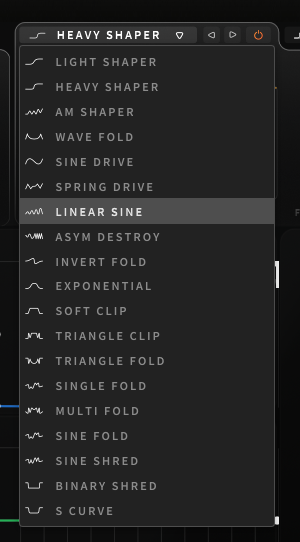
Loads of distortion shapes. You get a ton of algorithms here, each with corresponding shape, depth, frequency, clip, time and feedback controls. The time controls can also be synced.
You get warm, analog-style distortion and drive, wave folding in various shapes and colors, and clipping. But I find it terrifically useful to have those little icons and visual feedback. It’s far better than labeling analog simulations with the names of particular components or individual pieces of gear. Aside from the fact that the vast majority of producers today won’t have encountered a lot of that equipment, it’s a more precise and realistic way to think about what you’re doing even if you have.
Combine shape (for choosing harmonics) with amplitude modulation, and you have a load of options just in this pane alone.
And remember, you don’t get one but three of these stages, with filter controls. The closest I’ve come to this in my own rig is the excellent d16 Devastator2 and Decimator2. Those are terrific, and well worth it especially if you can find a d16 subscription (as on Splice); they do have an interesting modeled sound. But their skeuomorphic interface lacks some of the feedback that Output offers here. And we’re far from done.
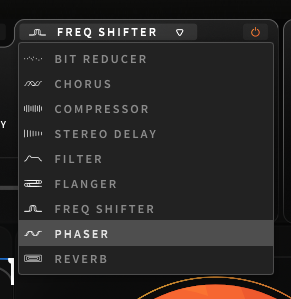
Also per stage, you get a choice of effects, including a bit reducer (actually containing individual bit depth and sample rate reduction parameters), chorus, compressor, delay, filter, flanger, frequency shifter, phaser, and reverb. At first, this struck me as overkill (well, it definitely is), but because it’s built into the plug-in, you can choose where in the three stages you add effects.
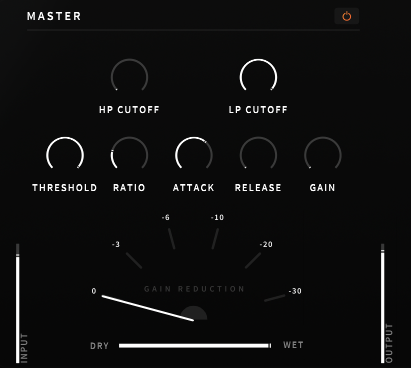
Keep gain and frequency under control. The big problem with most distortion plug-ins is that you quickly overwhelm a mix and add unwanted, uncontrollable distortion and harmonics. Thermal is set up so that you don’t experience that, either working on your own or in the existing presets.
You get both a per-stage AUTO setting for gain staging, and a master gain reduction/compressor and highpass and lowpass cutoff, on top of that refilter.
This makes such a difference in a digital context. Making squashed and dirty sound is fine with analog gear and stompboxes, but it’s a disaster in the middle of a crowded DAW session.
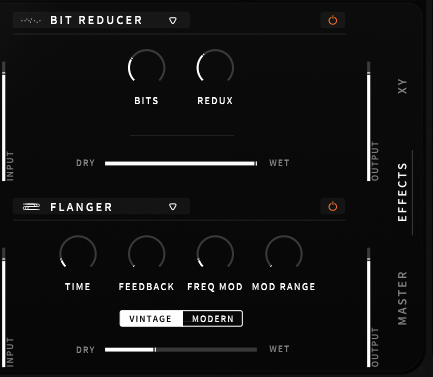
Still more effects and width. It’s almost unfair to call Thermal a distortion effect, as it’s equally useful in time-based and width/tone effects – enough so that you might build some presets with just a little drive and some flanger or chrous, for example. So even though it’s a big, splashy, California-style multi-effect able to mangle everything to Hell, it is also a nuanced, subtle sound tuner.
The master effects give you the same effects as in the three distortion/filter stages, but applied to the overall sound – though with an additional wet/dry.
There’s also the hugely useful WIDTH and TONE controls. The WIDTH section is maybe not immediately obvious (though the graphic helps a lot, and is clearly inspired by recent Ableton Live designs). SIDES adjusts side gain out of the whole stereo image – so set to minimum, your output is mono, and set to maximum, you get the full stereo. That presumes you have a stereo image, though, so WIDTH is a delay-based effect to add stereo image. The labels make sense, though I’m not sure why they aren’t the other way round left to right.
TONS is another low pass and high pass shelf.
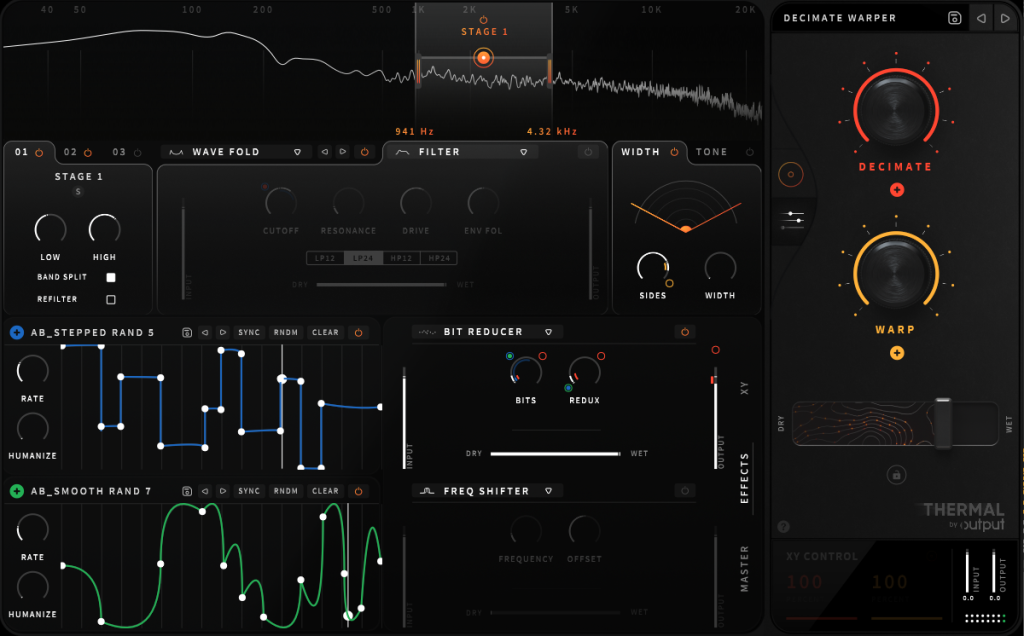
And yes, modulation and macros! You can modulate basically everything by dragging from the (+) icon on the two modulation sources to a parameter. Modulation sources can be run free or clocked to your host, and there are useful CLEAR and RNDM controls plus a load of preset shapes and the ability to store your own.
And Output has reproduced their excellent Humanize control and accompanying graphics.
The one downside of that modulation is, you are treated to a file dialog if you want to go to a specific preset, and it can be a little tedious adding shapes apart from random ones. (You can right click and drag to add nodes; it just takes a little patience.)
You can also map the two X/Y controls the same way. I do wish we had four or eight macros instead of two. I get the X/Y usefulness, but it winds up being simplistic given the number of layers and modules in Thermal. Of course, you can likely do this in your host of choice.
Putting it together. All in all, this is one beast of a multi-effects distortion/shaper/effect plugin. I don’t find the US$149 price outrageous given all it can do. Other plug-ins have gone this route, but none does this much, this accurately (even the formerly Camel Audio stuff Apple recently added to Logic Pro).
Probably the biggest competition is in fully-modular environments – and at least on my system, Thermal will have to compete with VCV Rack once the latter becomes available as a plug-in. And as I said, d16 has some strong competition, broken into different effects – just with skeuomorphic interfaces and a more retro approach.
If there were any criticism here, it’s that it can be overwhelming to have this much control in a single effect. But I find the solution to that, paradoxically, is to ignore the presets so you can easily and quickly apply the distortion, filtering, and gain and width as you see fit. The interface does make it easy to dive down and do that.
Look, I think you really don’t want this amount of modulation and multi-effects most of the time. But I think what makes Thermal absolutely indispensable to almost anyone is really its stage, gain, and filter controls. It is finally possible with a single plug-in to hone in on particular sonic characteristics you want, not only with your ears, but with your eyes and hands.
You can still add as much dirt, grit, and Satanic apocalyptic destruction as you want – but you can aim all of that.
Once you get that – well, once I got that – Thermal is one of those plug-ins you’ll want to keep around.